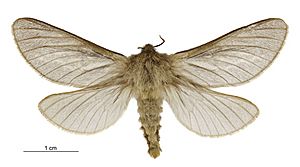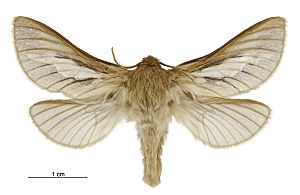Sphagnum porina moth facts for kids
Quick facts for kids Sphagnum porina moth |
|
|---|---|
 |
|
| Female | |
 |
|
| Male | |
| Scientific classification |
The sphagnum porina moth (scientific name: Heloxycanus patricki) is a special type of moth. It belongs to a group called Hepialidae, also known as ghost moths. This moth is the only species in its genus, Heloxycanus. You can only find this moth in New Zealand, which means it's endemic there. The Department of Conservation has listed it as "At Risk, Declining." This means its numbers are going down.
Contents
Discovering the Sphagnum Porina Moth
This moth was first officially described in 1994. A scientist named John S. Dugdale did the description. He used a moth specimen found by Brian Patrick. Brian found this moth at Danseys Pass on April 8, 1979. The moth was named H. patricki to honor its discoverer, Brian Patrick. The original specimen used for its description is kept at the New Zealand Arthropod Collection.
What Does This Moth Look Like?
The sphagnum porina moth has different sizes depending on if it's a male or female. Female moths have a wingspan of about 48 to 55 millimeters. Male moths are a bit smaller, with wingspans between 40 and 45 millimeters.
Their colors can also vary. Moths from the southern parts of New Zealand are often a smoky brown color. They have a less noticeable stripe on their front wings. Their antennae are also shorter at the very tip. Moths from the northern and western areas are more yellowish-fawn. They have a clear white stripe on their front wings.
Where Do These Moths Live?
The sphagnum porina moth is only found in New Zealand. It lives in several regions on the South Island. These include the Otago Lakes, Central Otago, Dunedin, Southland, Fiordland, and Stewart Island.
Life Cycle and Behavior
The life cycle of H. patricki usually takes two years. This means that you'll see the most adult moths in odd-numbered years. These moths are considered semi-aquatic, meaning they live partly in water. Scientists believe the young moths (larvae) eat the root-like parts of moss, called rhizoids.
When the adult moths come out, you can often see their empty pupa cases. These cases stick up from the moss where they grew. H. patricki moths appear late in the autumn. They usually start to emerge in late March and finish by mid-June. In the Otago region, they tend to emerge between mid-April and early June.
Moth Habitat
This moth lives in specific wet, mossy places. You can find them in coastal and alpine moss bogs. They also live in mires, blanket bogs, and peatlands. They especially like Sphagnum bogs in the southern part of New Zealand. These wet, spongy areas are important for their survival.
Why This Moth Needs Our Help
The sphagnum porina moth is listed as "At Risk, Declining" in the New Zealand Threat Classification System. This means its population is shrinking. There are a few reasons for this. First, these moths cannot travel very far. Second, they only live in a small part of southern New Zealand. Finally, their natural homes (habitats) are being lost. Protecting these special mossy areas is important to help this unique moth survive.

